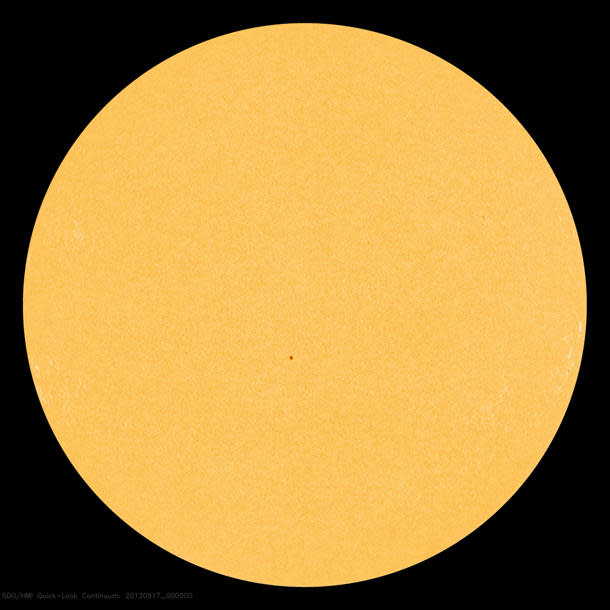 Science and Weather
Science and WeatherThe Sun goes strangely quiet right at solar maximum
Right at a time when it should be riddled with sunspots and alive with explosive solar flares and coronal mass ejections, the Sun is strangely quiet, with just a single sunspot marring an otherwise pristine surface.
Although it looks constant from our everyday perspective, the Sun is what's called a 'variable star'. It gets more active and then it calms down again, running on a fairly regular 11 year schedule between maximums. This year, 2013, is supposed to be the latest maximum, but it's turning out to be a pretty weak one — the weakest since we started to keep track, in fact.
[ Related: NASA says that sun’s magnetic field is preparing to flip ]
One explanation for both the so-far disappointing maximum and the current calm Sun could be that we're having a 'twin peak' maximum.
Sunspot activity reached an extreme peak, even above the predicted amount, back in late 2011. Since then, activity has been dropping and now we could be at the bottom of the valley between the peaks. That means that sunspot activity should increase again towards the end of the year and continue to increase through 2014.
[ More Geekquinox: Amazing NASA video shows the moon like you’ve never seen it ]
One issue this highlights is that, although we know quite a bit about our Sun, we haven't learned everything about it yet. It still has surprises lurking under the surface.
However, with NASA satellites like the Solar Dynamic Observatory, the Solar and Heliospheric Observatory, their twin STEREO satellites that give us a look at the other side of the Sun, and the numerous other ground- and space-based solar telescopes, we learn more all the time. NASA is even adding to their fleet.
They recently launched IRIS which will be watching the Sun's atmosphere, and they've revived a mothballed satellite called Triana (or 'GoreSat'), giving it a new name and a new purpose, as DSCOVER, the Deep Space Climate Observatory. This 'new' satellite is set to launch in 2015, and it will sit at a point directly between us and the Sun, to keep an eye out for solar flares and coronal mass ejections that could affect Earth.
(Images courtesy: NASA/SDO)
Geek out with the latest in science and weather.
Follow @ygeekquinox on Twitter!




